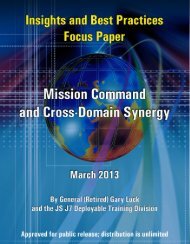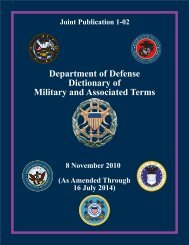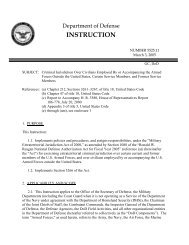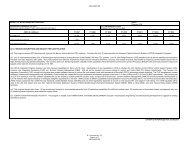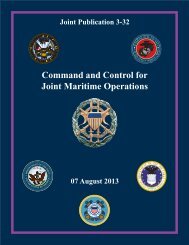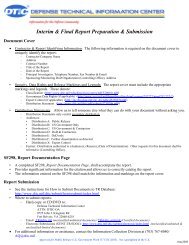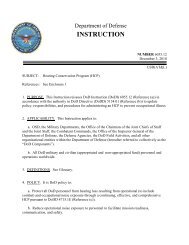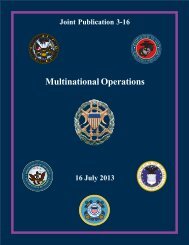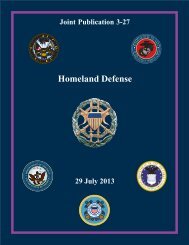JP 1, Doctrine for the Armed Forces of the United States - Defense ...
JP 1, Doctrine for the Armed Forces of the United States - Defense ...
JP 1, Doctrine for the Armed Forces of the United States - Defense ...
Create successful ePaper yourself
Turn your PDF publications into a flip-book with our unique Google optimized e-Paper software.
<strong>Doctrine</strong> Governing Unified Direction <strong>of</strong> <strong>Armed</strong> <strong>Forces</strong><br />
(a) An alliance is a relationship that results from a <strong>for</strong>mal agreement (e.g.,<br />
treaty) between two or more nations <strong>for</strong> broad, long-term objectives that fur<strong>the</strong>r <strong>the</strong> common<br />
interests <strong>of</strong> <strong>the</strong> members. Operations conducted with units from two or more allies are<br />
referred to as combined operations.<br />
(b) A coalition is an ad hoc arrangement between two or more nations <strong>for</strong><br />
common action. Coalitions are <strong>for</strong>med by different nations with specific objectives, usually<br />
<strong>for</strong> a single occasion or <strong>for</strong> longer cooperation in a narrow sector <strong>of</strong> common interest.<br />
Operations conducted with units from two or more coalition members are referred to as<br />
coalition operations.<br />
(3) Cultural, psychological, religious, economic, technological, in<strong>for</strong>mational, and<br />
political factors as well as transnational dangers all impact multinational operations. Many<br />
contingency plans to deter or counter threats are prepared within <strong>the</strong> context <strong>of</strong> a treaty or<br />
alliance framework. Sometimes <strong>the</strong>y are developed in a less structured coalition framework,<br />
based on temporary agreements or arrangements. Much <strong>of</strong> <strong>the</strong> in<strong>for</strong>mation and guidance<br />
provided <strong>for</strong> unified action and joint operations are applicable to multinational operations.<br />
However, differences in laws, doctrine, organization, weapons, equipment, terminology,<br />
culture, politics, religion, and language within alliances and coalitions must be considered.<br />
Normally, each alliance or coalition develops its own plans and orders to guide multinational<br />
action.<br />
(4) No single command structure best fits <strong>the</strong> needs <strong>of</strong> all alliances and coalitions.<br />
Each coalition or alliance will create <strong>the</strong> structure that best meets <strong>the</strong> objectives, political<br />
realities, and constraints <strong>of</strong> <strong>the</strong> participating nations. Political considerations heavily<br />
influence <strong>the</strong> ultimate shape <strong>of</strong> <strong>the</strong> command structure. However, participating nations<br />
should strive to achieve unity <strong>of</strong> ef<strong>for</strong>t <strong>for</strong> <strong>the</strong> operation to <strong>the</strong> maximum extent possible,<br />
with missions, tasks, responsibilities, and authorities clearly defined and understood by all<br />
participants. While command relationships are well defined in US doctrine, <strong>the</strong>y are not<br />
necessarily part <strong>of</strong> <strong>the</strong> doctrinal lexicon <strong>of</strong> nations in an alliance or coalition.<br />
b. Multinational Unity <strong>of</strong> Ef<strong>for</strong>t. Attaining unity <strong>of</strong> ef<strong>for</strong>t through unity <strong>of</strong> command<br />
<strong>for</strong> a multinational operation may not be politically feasible, but it should be a goal. There<br />
must be a common understanding among all national <strong>for</strong>ces <strong>of</strong> <strong>the</strong> overall aim <strong>of</strong> <strong>the</strong> MNF<br />
and <strong>the</strong> plan <strong>for</strong> its attainment. A coordinated policy, particularly on such matters as<br />
multinational <strong>for</strong>ce commanders’ (MNFCs’) authority over national logistics (including<br />
infrastructure), ROE, fratricide prevention, and ISR is essential <strong>for</strong> unity <strong>of</strong> ef<strong>for</strong>t. While <strong>the</strong><br />
tenets discussed below cannot guarantee success, ignoring <strong>the</strong>m may lead to mission failure<br />
due to a lack <strong>of</strong> unity <strong>of</strong> ef<strong>for</strong>t.<br />
(1) Respect. In assigning missions, <strong>the</strong> commander must consider that national<br />
honor and prestige may be as important to a contributing nation as combat capability. All<br />
partners must be included in <strong>the</strong> planning process and <strong>the</strong>ir opinions must be sought in<br />
mission assignment. Understanding, consideration, and acceptance <strong>of</strong> partner ideas are<br />
essential to effective communication across cultures, as are respect <strong>for</strong> each partner’s culture,<br />
religion, customs, history, and values. Junior <strong>of</strong>ficers in command <strong>of</strong> small national<br />
II-21



